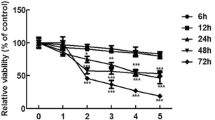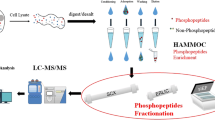Abstract
In the present study, we developed a novel proteomic research strategy named antigen-subtracted 2-DE/MS strategy and applied it to comparative proteomic analysis of anti-benzo(a)pyrene-7,8-dihydrodiol-9,10-epoxide-transformed human bronchial epithelial cell line (16HBE-C) and its parental cell line (16HBE) G0/G1 cells. Following pre-purification by ammonium sulfate precipitation, rabbit antibodies against 16HBE G0/G1 cells were coupled with protein A/G PLUS-agarose under the maximal coupling rate of about 50%. The agarose-antibody complex was then used in immunoprecipitation known as antigen subtraction. When the mass ratio of antibody to the sample was 2.5–3:1, the subtraction rates for 16HBE and 16HBE-C G0/G1 cell proteins were 44 and 34%, respectively. Both subtracted and unsubtracted samples were then subjected to the 2-DE resolution. In 16HBE-subtracted 2-DE maps, 315 protein spots were subtracted and 49 new protein spots were detected, whereas in 16HBE-C-subtracted 2-DE maps, 287 protein spots were subtracted and 33 new protein spots were detected. Taken together, antigen subtraction results in 65 new protein spots being allowed to be detected, therefore, makes it possible to get more information of the samples. Finally, 4 protein spots only detected in 16HBE-C-subtracted 2-DE maps were analyzed by the Q-TOF MS/MS, and successfully identified as U6 snRNA-associated Sm-like protein LSm3, 60S acidic ribosomal protein P1, Peroxiredoxin-6 and 60S acidic ribosomal protein P2. These proteins are involved in carcinogenesis, oxidation stress and protein synthesis. In conclusion, the antigen-subtracted 2-DE/MS strategy could reduce the complexities of protein samples and therefore, improve the resolution for the sample analysis.




Similar content being viewed by others
References
Brunet S, Thibault P, Gagnon E, Kearney P, Bergeron JJ, Desjardins M (2003) Organelle proteomics: looking at less to see more. Trends Cell Biol 13:629–638
Henrich S, Cordwell SJ, Crossett B, Baker MS, Christopherson RI (2007) The nuclear proteome and DNA-binding fraction of human Raji lymphoma cells. Biochim Biophys Acta 1774:413–432
Jiang Y, Chen J, Chen X (2001) Malignant transformation of human bronchial epithelial cells induced by benzo(a)pyrene metabolite dihydroxyepoxy benzopyrene. Wei Sheng Yan Jiu 30:129–131
Kennedy S (2001) Proteomic profiling from human samples: the body fluid alternative. Toxicol Lett 120:379–384
Kikuchi T, Carbone DP (2007) Proteomics analysis in lung cancer: challenges and opportunities. Respirology 12:22–28
Lyng H, Brøvig RS, Svendsrud DH, Holm R, Kaalhus O, Knutstad K, Oksefjell H, Sundfør K, Kristensen GB, Stokke T (2006) Gene expressions and copy numbers associated with metastatic phenotypes of uterine cervical cancer. BMC Genom 7:268
Umar A, Jaremko M, Burgers PC, Luider TM, Foekens JA, Pasa-Tolic L (2008) High-throughput proteomics of breast carcinoma cells: a focus on FTICR-MS. Exp Rev Proteom 5:445–455
Wu C, Wang Y, Zou M, Shan Y, Yao G, Wei P, Chen G, Wang J, Xu D (2007) Prokaryotic expression, purification, and production of polyclonal antibody against human polypeptide N-acetylgalactosaminyltransferase 14. Protein Expr Purif 56:1–7
Zhang S, Fu J, Zhou Z (2005) Changes in the brain mitochondrial proteome of male Sprague–Dawley rats treated with manganese chloride. Toxicol Appl Pharmacol 202:13–17
Zhao P, Zhong W, Ying X, Yuan Z, Fu J, Zhou Z (2008) Manganese chloride-induced G0/G1 and S phase arrest in A549 cells. Toxicology 250:39–46
Acknowledgments
This work is supported by China National Key Basic Research and Development Program (No. 2002CB512906) and National Nature Science Foundation of China (No. 30471470, No. 30671781 and No. 30771995). We thank Prof. Qingyi Wei of Department of Epidemiology, The University of Texas M.D. Anderson Cancer Center for great help in preparation of the manuscript.
Conflict of interest statement
The authors declare no conflict of interest.
Author information
Authors and Affiliations
Corresponding authors
Additional information
P. Zhao and L. Zhang contributed equally to this work.
Electronic supplementary material
Below is the link to the electronic supplementary material.
Rights and permissions
About this article
Cite this article
Zhao, P., Zhang, L., Zhong, W. et al. Antigen-subtracted 2-DE/MS strategy, a novel proteomic analysis platform. Arch Toxicol 85, 35–41 (2011). https://doi.org/10.1007/s00204-010-0539-3
Received:
Accepted:
Published:
Issue Date:
DOI: https://doi.org/10.1007/s00204-010-0539-3




